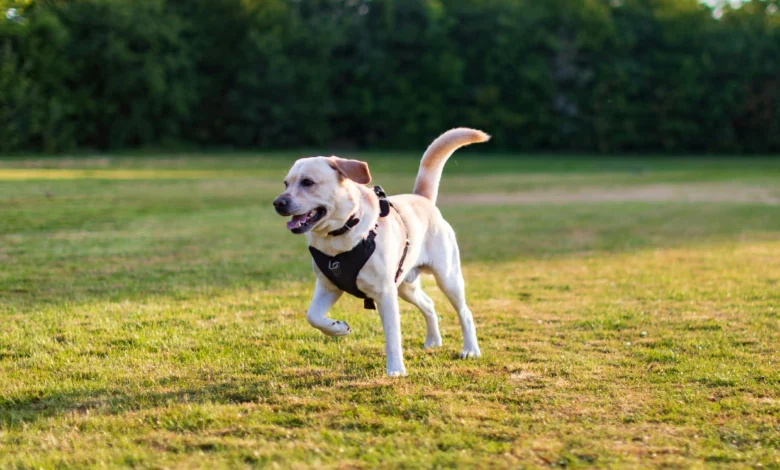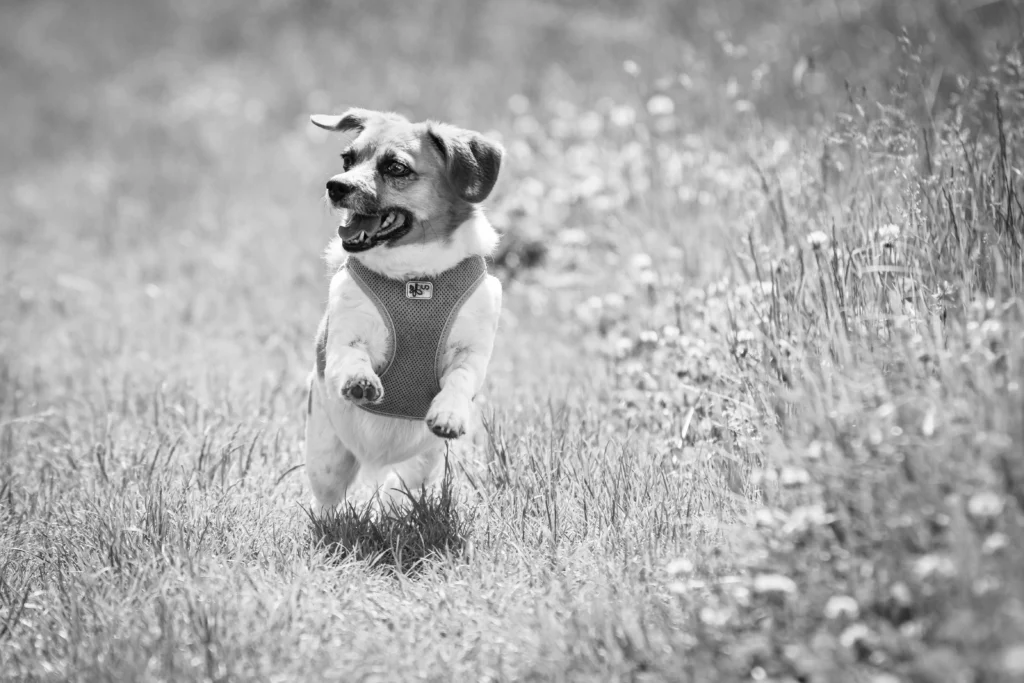Is Your Puppy Overstimulated? Tips to Calm an Excitable Pup

You’ve just brought home your bouncing ball of fur, ready for endless games and cuddles. But lately, those zoomies turn into nipping, barking, or frantic behavior that leaves you both exhausted. Sound familiar? Many new pet parents mistake this frenzy for normal puppy energy, not realizing their little companion might be drowning in sensory overload.
Modern homes buzz with stimuli – flashing screens, noisy appliances, and constant activity. For developing dogs, this environment can overwhelm their still-growing nervous systems. Signs like relentless biting, inability to settle, or hyperactivity often point to overstimulation, not just youthful excitement.
Research shows young puppies need 18-20 hours of daily rest. Without proper downtime, they become overtired toddlers in fur coats – cranky and reactive. This article blends expert insights about canine behavior with practical training strategies you can use today. Discover how to create calming spaces, establish crate routines, and use toys strategically to help your companion recharge.
Understanding Overstimulation in Puppies
Young dogs experience the world through heightened senses, which can quickly turn overwhelming. When their developing brains receive more input than they can process, it leads to overstimulation – a state where environmental factors like loud noises, bright lights, or constant interaction push them past healthy limits.
What Is Overstimulation?
This condition occurs when a dog’s nervous system gets flooded by stimuli. Imagine a toddler at a carnival – the lights, sounds, and crowds become too much. Puppies face similar challenges in busy homes. Common triggers include:
- Frequent visitors or chaotic play sessions
- Blaring TVs or humming appliances
- Rough handling by children
Common Behavioral Indicators
Watch for these signs of sensory overload:
- Zooming in circles without stopping
- Nipping despite redirection attempts
- Whining or barking that escalates over time
Differences Between Excitement and Overload
A happy, energetic puppy will settle after play. An overstimulated one can’t switch off. Key distinctions include:
- Excitement: Short bursts, responsive to commands
- Overload: Prolonged hyperactivity, ignoring cues
Veterinary behaviorists note that dogs experiencing true sensory stress often pant heavily or avoid eye contact. Recognizing these signals helps owners intervene before meltdowns occur.
Recognizing Signs: Is Your Puppy Overstimulated

Young canines often struggle to communicate discomfort until they reach breaking point. Learning to read subtle body language helps owners spot distress before it escalates. Watch for patterns that differ from typical excited behavior during daily activities.
Physical Signs and Body Language
A stressed dog often shows visible changes. Dilated pupils, excessive panting without physical exertion, and repetitive pacing signal sensory overload. Other signs include:
- Whale eye (showing whites of eyes)
- Stiff tail held high or tucked tightly
- Yawning when not tired
“Canine stress signals often get misinterpreted as disobedience. A licking tongue or turned head might be cries for help.”
Emotional and Behavioral Responses
Overwhelmed puppies frequently lose focus during training sessions. You might notice sudden snapping at shadows or refusal to take favorite treats. Key emotional indicators include:
| Signal Type | Examples | Immediate Action |
|---|---|---|
| Hyperactivity | Uncontrollable zoomies | Quiet space with dim lighting |
| Confusion | Circling furniture | Stop play, offer chew toy |
| Stress | Excessive scratching | Calming massage |
Owners should watch for rapid barking that increases in pitch. This often precedes nipping or destructive behavior. Early intervention prevents long-term stress patterns from developing.
Common Causes and Triggers in an Excitable Pup
A bustling household often hides hidden stressors for developing canines. While playful energy seems endless, certain environmental factors and daily patterns can push young dogs beyond their coping abilities. Recognizing these triggers helps create balanced routines that support healthy growth.
External Stimuli and Sensory Overload
Modern homes bombard puppies with intense stimuli. Common culprits include:
- Blaring music or TV volume exceeding 70 decibels
- Frequent visitors creating unpredictable interactions
- Flickering screens from multiple devices
These elements overwhelm developing dogs, whose hearing detects frequencies up to 45,000 Hz. A study in Applied Animal Behavior Science found chaotic environments increase stress hormones by 58% in young canines.
Inconsistent Routines and Excessive Interaction
Erratic schedules confuse dogs learning world patterns. Key issues involve:
| Trigger Type | Common Examples | Management Strategy |
|---|---|---|
| Social Overload | Constant petting by family members | Scheduled quiet hours |
| Activity Shifts | Varying walk/meal times | Digital reminders for consistency |
| Mixed Signals | Allowing jumping sometimes | Clear household rules |
Owners often unintentionally reinforce stress through excited greetings or lengthy play sessions. Balanced training combines structured activities with designated rest periods. Gradually introducing new stimulation helps build resilience without overwhelming developing brains.
Effective Training and Positive Reinforcement Techniques
Smart redirection turns chaotic moments into teachable opportunities. When dogs face overwhelming stimuli, structured training helps them refocus energy productively. Studies show 78% of unwanted behaviors decrease when owners use reward-based methods consistently.
Redirecting with Treats, Toys, and Commands
High-value treats work like magic during sensory overload. Carry soft, smelly snacks to capture attention when barking starts or zoomies strike. Pair these with simple commands like “sit” or “touch” to create positive associations.
Interactive toys serve dual purposes:
- Food puzzles redirect chewing urges
- Tug ropes channel biting into controlled play
- Scent games engage noses instead of racing minds
“Reward calm choices immediately – even two seconds of settled behavior deserves celebration,” advises certified trainer Mia Carter.
| Scenario | Tool | Technique |
|---|---|---|
| Jumping guests | Kibble pouch | Ask for “sit” before greetings |
| Barking at noises | Kong toy | Initiate “find it” searches |
| Leash pulling | Chicken bites | Reward loose-leash walking |
Consistency matters most. Practice 5-minute sessions daily using the same cues. Over time, dogs learn to self-regulate by seeking approved activities when stressed. This builds trust and prevents future overstimulation episodes.
Creating a Peaceful Home Environment
A calm living space acts like a reset button for developing canines. By designing intentional zones and controlling sensory input, you help your companion process daily experiences without becoming overwhelmed.
Establishing a Calming Space
Choose a low-traffic area for your dog’s sanctuary. A corner with a crate covered by blankets creates a den-like feel. Add chew-proof bedding and familiar-smelling items like worn t-shirts.
Ambient noise machines mask disruptive sounds. Studies show 62% of dogs settle faster with steady white noise. Rotate calming tools weekly to maintain interest:
- Frozen lick mats with peanut butter
- Pheromone diffusers near resting spots
- Weighted blankets for anxious days
Minimizing Unwanted Stimuli
Create visual barriers using baby gates or room dividers during hectic activities. Close curtains facing busy streets and establish “quiet hours” with reduced household noise.
Consistent routines prevent sensory overload. Feed meals and schedule walks at fixed times. Use this table to balance stimulation:
| Calming Tools | Common Triggers | Solutions |
|---|---|---|
| Soundproof panels | Loud appliances | Run dishwasher at night |
| Puzzle feeders | Chaotic play | 10-minute structured games |
| Elevated beds | Crowded spaces | Designate dog-only zones |
Remember: Prevention beats correction. Proactively managing your dog’s environment reduces stress spikes before they escalate. Small daily adjustments create lasting calm.
Physical and Mental Enrichment Activities

Balanced energy management transforms chaotic pups into focused companions. Young dogs thrive when their days blend movement with brainwork. Structured activities channel natural curiosity into healthy outlets while preventing destructive habits.
Fuel Bodies, Focus Minds
Daily walks do more than burn energy – they teach leash manners and environmental awareness. Aim for 5 minutes per month of age, twice daily. Pair physical exercise with obedience drills like “sit-stay” at intersections.
Interactive fetch sessions build impulse control. Wait for calm behavior before throwing the ball. Certified trainer Lucas Reed notes: “Dogs working for rewards develop better stress resilience than those with unlimited access to toys.”
Smart Play for Busy Brains
Rotate puzzle feeders weekly to maintain novelty. Try these options:
- Snuffle mats hiding kibble in fabric folds
- Moving treat dispensers that roll unpredictably
- Frozen Kongs stuffed with yogurt and blueberries
Scent games sharpen natural abilities. Hide treats under cups or in cardboard boxes. Start with easy finds, gradually increasing difficulty as skills improve.
Cognitive Workouts Matter
Mental challenges tire puppies faster than physical exertion alone. Teach new tricks in 3-minute sessions using these methods:
| Skill Level | Activity | Reward |
|---|---|---|
| Beginner | Touch target stick | Soft training bites |
| Intermediate | Identify toy by name | Chicken jerky |
| Advanced | Retrieve specific items | Playtime extension |
Alternate high-energy play with calm periods. After 15 minutes of training, offer a chew bone in their crate. This rhythm helps young dogs process stimulation without overload.
Crate Training, Nap Times, and Rest Strategies
Structure shapes behavior in growing canines. A predictable rhythm of rest and activity helps young dogs process their world without becoming overwhelmed. Proper downtime isn’t optional – it’s essential for emotional regulation and healthy development.
Building Sanctuary Through Routine
Crates become safe havens when introduced positively. Use soft bedding and familiar scents to create a den-like environment. Feed meals inside to build positive associations, and keep the door open initially for voluntary naps.
Follow this age-based schedule to prevent overstimulation:
| Age (Months) | Awake Time | Nap Duration |
|---|---|---|
| 2-4 | 45-60 mins | 2-2.5 hours |
| 5-8 | 1-1.5 hours | 1.5-2 hours |
| 9+ | 2 hours | 1-1.5 hours |
Stick to consistent bedtimes – even on weekends. A study in Canine Behavior Journal found structured sleep reduces hyperactivity by 43% in young dogs. Watch for these signs of sufficient rest:
- Voluntary retreat to the crate
- Gentle play instead of frantic biting
- Calm responses to household noises
Gradually increase awake periods as your companion matures. Pair nap times with white noise or calming music to mask disruptive sounds. Remember: Well-rested puppies make better learners and family members.
Related post: Why Is My Dog Panting at Night?
Conclusion
Raising a well-adjusted companion requires understanding their unique needs. Young dogs thrive when owners recognize stress signals like excessive barking or restlessness. Environmental triggers and inconsistent routines often disrupt their balance, making structured training essential.
Creating calm spaces and using positive reinforcement helps manage sensory challenges. A predictable schedule with designated playtimes and naps supports healthy development. Physical exercise paired with mental puzzles prevents boredom while teaching focus.
Balanced care transforms chaotic energy into confident behavior. Implement these strategies to help your dog’s nervous system reset naturally. Start today by assessing noise levels and establishing clear rest periods.
Remember: Small changes create lasting results. Early recognition of stress patterns and consistent responses prevent overstimulation from becoming habitual. Your efforts lay the foundation for a calm, happy companion who navigates life’s excitement with resilience.
FAQ
How can I tell if my puppy is overstimulated instead of just excited?
Look for signs like excessive barking, frantic movements, or inability to settle. Overstimulation often includes panting, dilated pupils, or avoidance behaviors. Excitement usually fades quickly, while overload persists even after removing triggers.
What environmental changes help reduce sensory overload?
Create a quiet zone with minimal noise and visual distractions. Use calming tools like chew toys or blankets. Limit exposure to loud sounds, crowded spaces, or flashing lights during high-energy periods.
Are certain breeds more prone to becoming overstimulated?
High-energy breeds like Border Collies or Jack Russell Terriers may react strongly to stimuli. However, any dog can experience overload without proper routine, training, or outlets for their energy.
How do puzzle toys support cognitive balance?
Interactive games like Kongs or snuffle mats engage their brain constructively. These tools channel energy into problem-solving, reducing restlessness and preventing boredom-related hyperactivity.
Can crate training help an overstimulated puppy?
Yes. A crate provides a safe retreat for decompression. Pair it with soft bedding and low lighting to encourage relaxation. Gradually introduce crate time using treats and positive reinforcement.
What role does routine play in managing hyperactivity?
Consistent schedules for meals, walks, and naps build predictability. Structure helps pups feel secure, lowering stress from chaotic environments or irregular interactions.
How much daily exercise is ideal for preventing overload?
Aim for 30–60 minutes of activity split into short sessions. Adjust based on age and breed. Pair physical play with mental challenges like scent work to avoid overtiring their developing bodies.
When should I seek professional help for my dog’s behavior?
If calming techniques fail or symptoms escalate (e.g., aggression, destructive habits), consult a certified trainer or vet. Underlying health issues or anxiety disorders may require specialized care.



